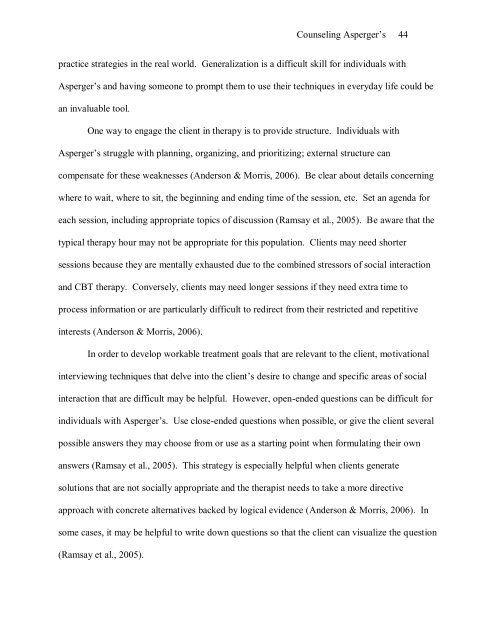COUNSELING ADULTS WITH ASPERGER‟S - School of Health ...
COUNSELING ADULTS WITH ASPERGER‟S - School of Health ...
COUNSELING ADULTS WITH ASPERGER‟S - School of Health ...
Create successful ePaper yourself
Turn your PDF publications into a flip-book with our unique Google optimized e-Paper software.
Counseling Asperger‟s 44<br />
practice strategies in the real world. Generalization is a difficult skill for individuals with<br />
Asperger‟s and having someone to prompt them to use their techniques in everyday life could be<br />
an invaluable tool.<br />
One way to engage the client in therapy is to provide structure. Individuals with<br />
Asperger‟s struggle with planning, organizing, and prioritizing; external structure can<br />
compensate for these weaknesses (Anderson & Morris, 2006). Be clear about details concerning<br />
where to wait, where to sit, the beginning and ending time <strong>of</strong> the session, etc. Set an agenda for<br />
each session, including appropriate topics <strong>of</strong> discussion (Ramsay et al., 2005). Be aware that the<br />
typical therapy hour may not be appropriate for this population. Clients may need shorter<br />
sessions because they are mentally exhausted due to the combined stressors <strong>of</strong> social interaction<br />
and CBT therapy. Conversely, clients may need longer sessions if they need extra time to<br />
process information or are particularly difficult to redirect from their restricted and repetitive<br />
interests (Anderson & Morris, 2006).<br />
In order to develop workable treatment goals that are relevant to the client, motivational<br />
interviewing techniques that delve into the client‟s desire to change and specific areas <strong>of</strong> social<br />
interaction that are difficult may be helpful. However, open-ended questions can be difficult for<br />
individuals with Asperger‟s. Use close-ended questions when possible, or give the client several<br />
possible answers they may choose from or use as a starting point when formulating their own<br />
answers (Ramsay et al., 2005). This strategy is especially helpful when clients generate<br />
solutions that are not socially appropriate and the therapist needs to take a more directive<br />
approach with concrete alternatives backed by logical evidence (Anderson & Morris, 2006). In<br />
some cases, it may be helpful to write down questions so that the client can visualize the question<br />
(Ramsay et al., 2005).


